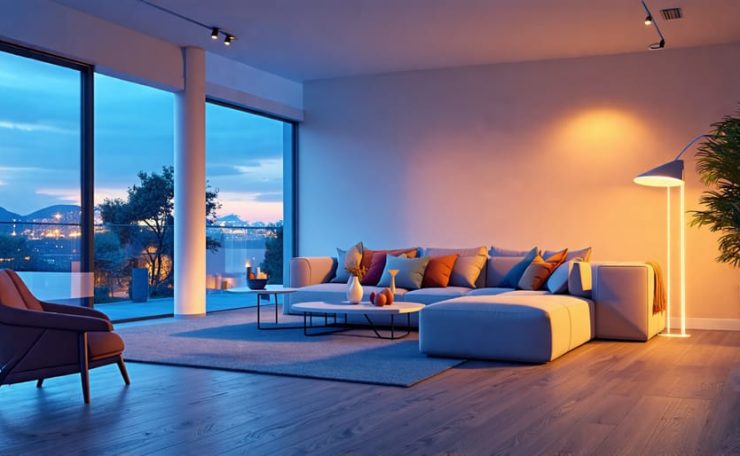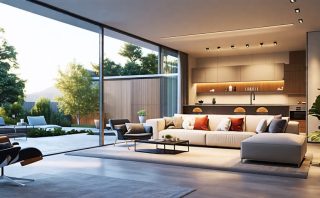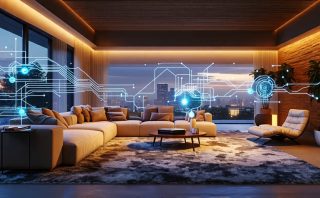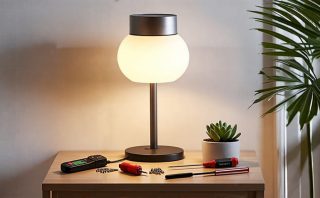Enhance interior design with adaptive lighting by selecting smart bulbs or fixtures that adjust brightness and color temperature. Implement sensors to automatically modify lighting based on natural light availability or activity patterns. Customize lighting scenes through mobile apps or smart home systems to suit different moods or functional needs. Prioritize energy-efficient solutions like LED technology to reduce utility costs while achieving optimal lighting conditions for any space.
Understanding Adaptive Lighting Technology

How Adaptive Lighting Works
Adaptive lighting systems utilize advanced technology to tailor lighting conditions to meet specific needs and preferences, enhancing ambiance and functionality across various settings. The core mechanism involves sensors and smart controls that dynamically adjust light levels based on factors such as time of day, available natural light, and occupancy. These systems often incorporate energy-efficient LED fixtures paired with smart bulbs that can change color and intensity. Central to adaptive lighting are motion detectors and photocells, which monitor movement and light conditions, ensuring optimal lighting while conserving energy.
Homeowners can benefit from adaptive lighting by having lights automatically dim or brighten, creating the perfect atmosphere for relaxation or productivity. For architects and interior designers, these systems offer flexibility and innovation, seamlessly integrating with design elements to enhance aesthetics and functionality. Event planners can employ adaptive lighting to instantly transform spaces, customizing illumination to suit various occasions and moods.
Similarly, commercial businesses can use adaptive lighting to improve customer experiences, create inviting environments, and reduce energy costs. By employing user-friendly apps and interfaces, users can easily program lighting schedules and settings from their devices, offering both convenience and personalization. Through continuous innovation, adaptive lighting continues to revolutionize how we interact with our environments, offering a blend of efficiency, comfort, and style.
Types of Adaptive Lighting Systems
Adaptive lighting systems are transforming spaces by integrating technology with illumination to create customizable environments. Among the available solutions, smart lighting is a popular choice. These systems use LED bulbs that can be controlled via a smartphone or voice-activated virtual assistants, allowing users to adjust brightness and color, and even set schedules remotely.
Another vital component in adaptive lighting is the use of sensors. These devices detect motion, occupancy, and even the amount of natural light in a room, enabling lights to adjust automatically based on the environment. This not only enhances energy efficiency but also adds a layer of convenience, as lights respond to real-time conditions without manual input.
Finally, control systems play a crucial role in managing adaptive lighting solutions. These systems, often using protocols such as Zigbee or Z-Wave, connect various lighting components and allow comprehensive management through centralized units. They provide a seamless integration of lighting with other smart home technologies, offering an unmatched level of adaptability and customization for any space.
Together, these systems bring a new level of sophistication to lighting solutions, making them ideal for homeowners, designers, and businesses aiming for efficiency and style.
Benefits of Adaptive Lighting

Energy Efficiency and Cost Savings
Adaptive lighting technology offers significant energy savings by automatically adjusting light levels to match the natural light available or the specific needs of a space. This reduction in unnecessary energy usage results in lower utility bills, making it an attractive solution for environmentally conscious homeowners and budget-focused businesses alike. By integrating sensors and smart controls, adaptive lighting systems ensure optimal performance without constant manual adjustments. For commercial spaces, these systems can be programmed to dim or brighten based on time of day or occupancy, ensuring that energy is used efficiently only when needed. Such customization not only enhances ambiance but also maximizes cost-effectiveness. Moreover, adaptive lighting’s ability to extend the life of bulbs further contributes to savings by reducing replacement costs. This blend of innovative technology and practical benefits makes adaptive lighting a smart investment for anyone seeking to improve both energy efficiency and financial savings in their lighting solutions.
Enhanced Comfort and Mood
Adaptive lighting is a transformative approach in interior design that fundamentally enhances comfort and mood by synchronizing with human needs. It dynamically adjusts light intensity and color temperature throughout the day, mirroring natural sunlight patterns. This not only helps maintain our circadian rhythms but also supports natural alertness and relaxation cycles, creating an effortlessly soothing environment. For homeowners seeking a personalized touch, adaptive lighting offers the flexibility to tailor lighting conditions to individual activities or preferences, whether reading, dining, or relaxing. Interior designers and architects can leverage this technology to craft spaces that not only look aesthetically pleasing but also promote well-being. For commercial businesses, adaptive lighting can improve employee productivity and customer satisfaction by ensuring optimal lighting conditions that adapt to various tasks and settings. Ultimately, integrating adaptive lighting solutions into any space can enhance ambiance, leading to improved mood and comfort for all users.
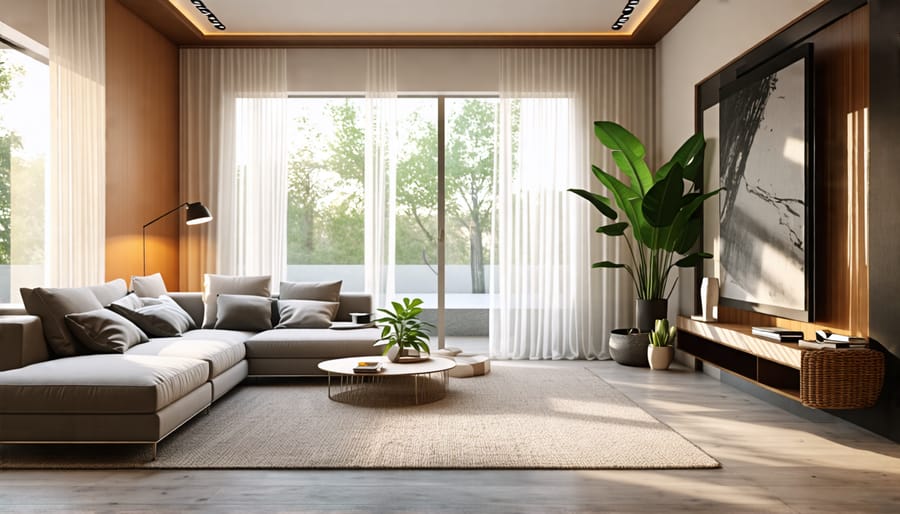
Adaptive Lighting in Interior Design
Design Considerations
When designing spaces with adaptive lighting, several key factors should be considered to achieve optimal results. First, understanding the functional requirements of the space is crucial, as different areas may have varying needs for light intensity and color temperature. Adaptive lighting allows you to tailor these elements based on specific activities, enhancing both mood and productivity. Integrating smart controls is another vital consideration, as they provide flexibility and ease of use for adjusting lighting settings via simple interfaces or automation. It’s also important to consider energy efficiency; choosing LED technologies can significantly reduce energy consumption and maintenance costs while offering a wide range of adaptive features. Moreover, aesthetics should not be overlooked—selecting lighting solutions that complement the design theme ensures a harmonious visual appeal. Consulting with professionals can provide personalized insights and product comparisons tailored to your needs, ensuring your adaptive lighting design is both functional and visually compelling.
Case Studies and Examples
Adaptive lighting has become a remarkable solution in various real-world applications, enhancing spaces by synchronizing with their environments. In residential settings, homeowners are increasingly implementing adaptive lighting systems to adjust the ambiance throughout the day, mimicking natural light patterns that support well-being. For instance, a smart home in Seattle uses adaptive lighting to transition from energizing daylight tones in the morning to warm, relaxing hues in the evening, optimizing both comfort and energy efficiency.
Interior designers have successfully incorporated adaptive lighting into retail environments to influence customer behavior. A notable example includes a boutique in New York that uses adaptive lights to highlight products dynamically, creating a unique shopping experience that encourages customer interaction and extended browsing time.
Additionally, commercial businesses such as hotels are adopting adaptive lighting to enhance guest experiences. A luxury hotel in London uses this technology to automatically adjust lighting based on the time of day and activity, from bright, welcoming lights in reception areas to soothing, dimmed settings in relaxation spaces, ensuring a tailored guest experience that aligns with circadian rhythms. These examples highlight how adaptive lighting can be artfully integrated to improve functionality and aesthetics across different settings.
Challenges and Solutions
Implementing adaptive lighting presents several challenges, but practical solutions can ensure its successful integration into spaces. One common challenge is the compatibility between adaptive lighting systems and existing infrastructure, such as wiring and fixtures. To address this, it is advisable to work with lighting professionals who can assess the current setup and recommend compatible products that meet both functionality and aesthetic requirements.
Another challenge is the initial cost and complexity associated with advanced adaptive lighting technologies. While the upfront investment may seem significant, focusing on long-term benefits such as energy efficiency and enhanced ambiance can justify these costs. Opt for scalable lighting solutions that allow gradual upgrades, making it easier to manage budget constraints.
User adaptability can also be a concern as adopting new technology may require a learning curve. This can be mitigated by selecting systems with user-friendly interfaces and providing users with comprehensive guidance and training materials. Many manufacturers offer personalized consultations to help design tailored lighting solutions that align with individual needs.
Finally, maintaining consistent lighting quality across variable settings can be challenging. It is important to select adaptive lighting systems with high-quality, adjustable luminaires that cater to different settings without compromising on effectiveness. By tackling these challenges with informed decisions and expert consultation, adaptive lighting can transform environments seamlessly and efficiently.
Conclusion
In conclusion, embracing adaptive lighting can transform your spaces by enhancing visual comfort, ambiance, and energy efficiency. This innovative approach to lighting allows for greater control and personalization, catering to diverse needs—from the calming warmth of a home setting to the dynamic demands of commercial environments. For homeowners and interior designers, adaptive lighting provides a versatile tool to create mood and enhance aesthetic appeal, while architects and event planners can leverage its flexibility to design dynamic and functional spaces. Commercial business owners will appreciate the potential energy savings and reduced operational costs. By understanding the capabilities of adaptive lighting systems, you can create environments that not only meet functional requirements but also enhance the overall experience within the space. We urge you to explore the benefits and possibilities of integrating adaptive lighting solutions into your projects—whether it’s new construction or a retrofit. Personalized consultations and detailed product comparisons are available to guide your selection process, ensuring an informed choice tailored to your specific needs. As you consider your options, remember that adaptive lighting is more than just illumination; it’s an investment in creating a harmonized environment that adapts to your lifestyle and professional requirements.

